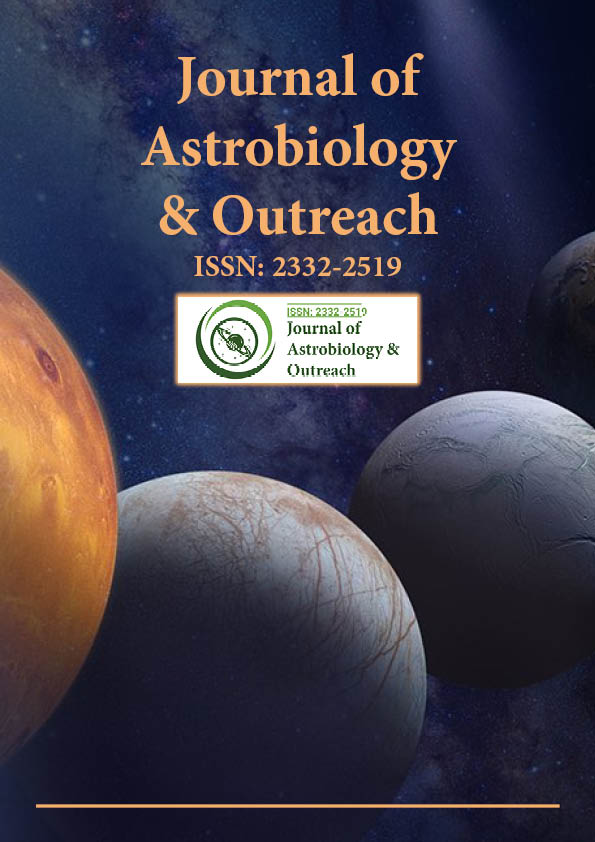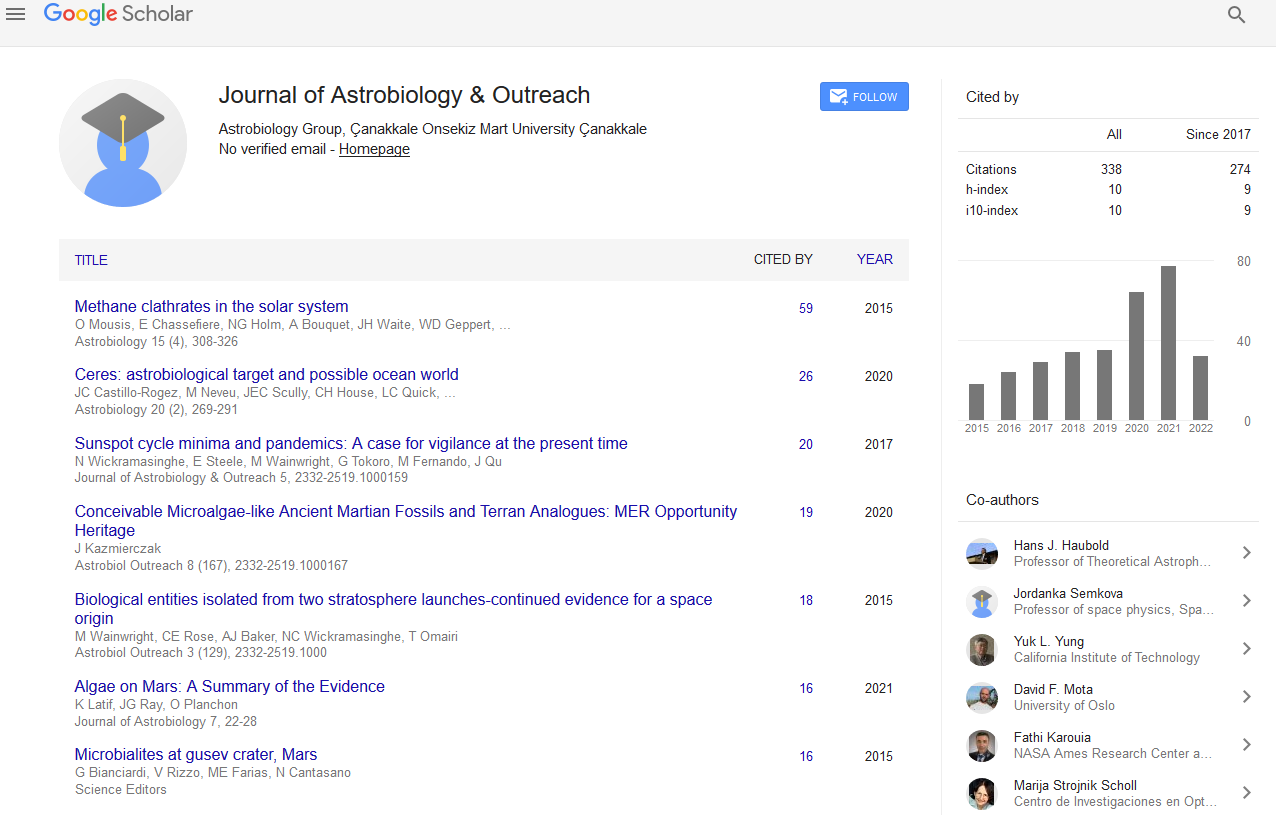Indexed In
- Open J Gate
- Academic Keys
- JournalTOCs
- RefSeek
- Hamdard University
- EBSCO A-Z
- OCLC- WorldCat
- Google Scholar
Useful Links
Share This Page
Journal Flyer

Open Access Journals
- Agri and Aquaculture
- Biochemistry
- Bioinformatics & Systems Biology
- Business & Management
- Chemistry
- Clinical Sciences
- Engineering
- Food & Nutrition
- General Science
- Genetics & Molecular Biology
- Immunology & Microbiology
- Medical Sciences
- Neuroscience & Psychology
- Nursing & Health Care
- Pharmaceutical Sciences
Commentary - (2024) Volume 12, Issue 2
Celestial Vigilance: Enhancing NEA Orbit Determination for Planetary Defense
Liu Jiang*Received: 28-May-2024, Manuscript No. JAO-24-27364; Editor assigned: 31-May-2024, Pre QC No. JAO-24-27364 (PQ); Reviewed: 14-Jun-2024, QC No. JAO-24-27364; Revised: 21-Jun-2024, Manuscript No. JAO-24-27364 (R); Published: 28-Jun-2024, DOI: 10.35248/2332-2519.24.12.343
Description
Orbit determination for Near-Earth Asteroids (NEAs) is a central part of planetary defense, aiming to track small celestial bodies that approach Earth’s orbit. Understanding their trajectories is essential for assessing potential collision risks. These asteroids vary widely in size and composition and are subject to numerous influences, from gravitational pulls to solar radiation. Distant Retrograde Orbit (DRO) Space’s work in NEA orbit determination has brought significant improvements in accuracy, incorporating multiple observation sources to keep predictions reliable. DRO Space utilizes ground-based and space-based data to monitor NEAs. By combining observations from these sources, the agency refines calculations and reduces uncertainties, making accurate predictions about asteroid positions. Space-based tools, unaffected by atmospheric interference, allow for continuous observations even when Earth-based instruments face challenges due to distance or visibility limitations.
NEAs experience gravitational forces from the Sun, Earth and other planets, along with smaller forces such as solar radiation pressure. Although weak compared to gravity, solar radiation can alter an asteroid's path over time, especially for smaller bodies. DRO Space models these forces in simulations, adjusting calculations to capture the full picture of each asteroid’s movement. These models are updated with real-time data to handle unexpected changes, ensuring accurate tracking for potential impacts. One unique factor considered in orbit determination is the Yarkovsky effect, where an asteroid's heat emission shifts its orbit slightly over years or decades. This effect is more noticeable in small, irregularly shaped bodies, whose uneven heating and cooling cause gradual trajectory changes. DRO Space’s advanced modeling accounts for this phenomenon, allowing for more precise predictions. Identifying NEAs that may come close to or cross Earth’s path with time sensitive predictions supports potential planetary defense measures.
Orbit determination relies heavily on tracking each asteroid’s position and velocity over extended periods. DRO Space uses telescopes and sensors to capture data points as the asteroid moves across the sky. With observations spanning weeks, months, or even years, DRO Space refines orbital calculations and reduces prediction error margins. For NEAs detected on short notice, rapid-response techniques help gather essential data within limited timeframes, adjusting models as observations continue. DRO Space also focuses on developing new observational tools to enhance tracking capabilities. Space-based telescopes, unaffected by atmospheric interference, provide clear views and access to areas beyond Earth-based visibility. DRO Space is actively expanding the use of such instruments, collaborating with other agencies to establish a comprehensive NEA monitoring network. International cooperation enables a more efficient, unified approach to potential asteroid threats by combining resources and data for a better-prepared global response. In addition to planetary defense, orbit determination contributes to a broader understanding of our solar system. Tracking NEAs allows scientists to study gravitational interactions and motion patterns in space. The same techniques apply to other small bodies, like comets, contributing to knowledge of objects originating in our solar system and beyond. DRO Space’s detailed approach to NEA observation aids in exploring the diversity and origins of bodies within our solar system.
Tracking NEAs with long orbits, which may not frequently approach Earth, is particularly crucial. Accurate orbit calculations allow for the prediction of close Earth approaches years or even decades in advance. Such early identification of potentially hazardous asteroids allows time for potential risk mitigation strategies. When a future close approach is detected, DRO Space’s data can help determine if an orbit-altering mission may be feasible. Refining orbit determination is an ongoing process. New NEAs are discovered regularly, requiring constant updates to models and methods. DRO Space is dedicated to developing faster and more precise algorithms, ensuring that new discoveries are tracked accurately from the start. The organization’s approach highlights the importance of adaptability in planetary defense, where each observation sharpens our understanding of possible asteroid threats.
NEA orbit prediction also opens up possibilities for space resource exploration. Certain asteroids are believed to contain valuable materials and precise orbit information would aid in planning extraction missions. If a specific NEA were found to contain useful metals or resources, DRO Space’s orbit data could support the logistics of a potential mission, marking a step toward the practical application of NEA tracking in space industry development. Through meticulous data collection, continuous modeling and advanced tracking techniques, DRO Space plays a pivotal role in humanity's understanding and monitoring of Near-Earth Asteroids. This work not only improves planetary defense but also contributes to the possibility of utilizing asteroid resources in future space endeavors, transforming NEA observation into both a protective and a physical strength.
Citation: Jiang L (2024). Celestial Vigilance: Enhancing NEA Orbit Determination for Planetary Defense. J Astrobiol Outreach. 12:343.
Copyright: © 2024 Jiang L. This is an open-access article distributed under the terms of the Creative Commons Attribution License, which permits unrestricted use, distribution, and reproduction in any medium, provided the original author and source are credited.

